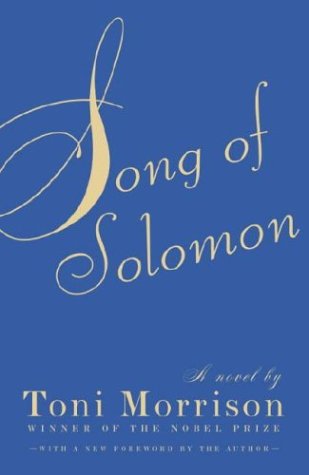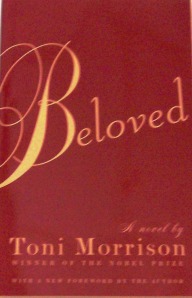Toni Morrison’s writing style is very unique, and it adds a lot of depth to her novels. Her uses of biblical references, characters, and how she divides up her novels creates draws her audience in and keeps them interested. In all three of her works The Bluest Eye, Song of Solomon, and Beloved, Morrison alludes to biblical references, which gives her novels a spiritual side. In Song of Solomon, Morrison refers to biblical ideas in the title of the novel and the character’s names. The title Song of Solomon comes from a book in the bible. Milkman overhears children singing a song about Solomon and after listening to the lyrics, he discovers the song was written about his grandfather. The names in Song of Solomon are also bible-related. There is a tradition in the Dead family that they pick random names from the bible. Pilate’s name was chosen because her father liked the way the letters looked, how some letters towered over others. Pilate’s name literally means “Christ-killer”. Milkman’s sisters also have names from the bible: 1st Corinthians and Magdalene. The Bluest Eye references the bible with the style in which Morrison writes; “And they took the ugliness in their hands, threw it as a mantle over them, and went about the world with it (109)”. This excerpt sounds like it would be something straight out of the bible. Beloved also references the bible in many different ways. Firstly, Morrison references the bible indirectly with the themes of sin, forgiving one another, and redemption found throughout the novel. Also, the story told where Denver and Beloved drink the milk and blood from Sethe’s breast has strong biblical undertones to it. It can be looked at as Denver and Beloved receiving the body and blood or Christ, or communion, from Sethe. The use of biblical references in the novels gives a new perspective to the ethical issues that Morrison presents.
Toni Morrison has a distinct style with her use of characters in all three of the novels. In all of the novels, although there is one main character, many character’s stories and point-of-views are shown. In Song of Solomon, even though Milkman is the main character, other characters such as Pilate, Hagar, and Guitar’s stories are told. This adds to the depth and complexity of the novel by being able to see a point-of-view opposite of Milkman. For instance, when reading Guitar’s story, the reader starts to believe his rational for being in the Seven Days Club and killing white people. It took a new narrator to get out of the mind of Guitar. Morrison is very good at letting her readers into the minds of her characters and telling them everything the character is feeling, seeing, or hearing. After only a few chapters into the book, the reader feels like a part of the story. In The Bluest Eye, although the main character is Pecola, most of the story is told through the main narrator, Claudia. Like Song of Solomon, The Bluest Eye also tells the point-of-view of the ‘bad guy’ in the novel. In The Bluest Eye, the ‘bad guy’ is Cholly, Pecola’s father, who rapes her. Previous to reading about the rape from Cholly’s point-of-view, Cholly’s life story is told. Because of the hard life he has had, the readers are not surprised that Cholly uses sexual violence to release some of his pent up anger. Although Cholly’s point-of-view does not erase the sins he has committed, it makes his actions a little more tolerable. In Beloved, there are many changes between narrators. It changes narrators so often that there were times when I was not able to tell who was narrating: Beloved, Sethe, or Denver. This not only adds to the complexity of the novel, it keeps the readers engaged at all times. One of the minor narrators in the novel, Stamp Paid, is not a part of Sethe’s family, but he is a white man from the town that observes the family at 124. This character shows what the outside view is of the family. The use of narrating characters, although confusing at times, adds to the complexity and depth of the novels by giving the readers of perspectives of the situation.
Morrison uses very unique ways to divide up her novels. Although all three of the novels are split up differently, Morrison uses the same motive for splitting up the stories. Song of Solomon is split up into two sections. The first section ends with Lena telling Milkman he is no longer part of the family. The second part Milkman embarks on a journey to find gold. He never finds the gold, but he learns a lot about himself and changes from a person full of hatred and greed to a person capable of love and kindness. The Bluest eye is divided into four sections, based on the seasons over a one year period. The novel begins with autumn and ends with summer. Beloved is divided into three sections. Each section begins with “124 was” and then an adjective. The first section begins “124 was spiteful, the second section begins “124 was loud” and the third sections starts with “124 was quiet”. Each simple statement about the place where the characters live says a lot in three words; it briefly summarizes the section that follows the sentence. In the beginning, the main character, Sethe, is still angry about her Sweet Home experience. The middle section is when the most action occurs, which would explain why 124 is described as loud. The last section is when the main issue of the novel has been resolved and things have calmed down, which is why 124 is described as quiet. Morrison divides her novels into sections to show the changes that are occurring in the novels. Her use of biblical references, characters, and how she sections off her novels add complexity to each story, which is more appealing to the readers.



Leave a comment